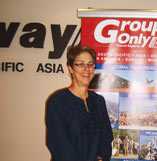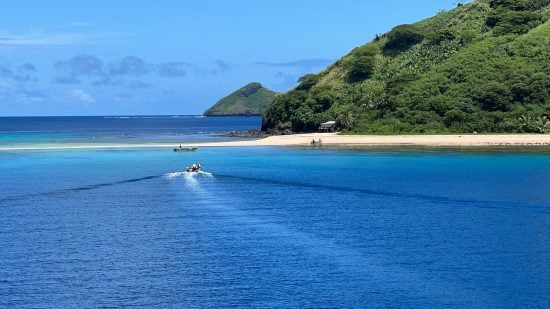A Group Destination Like No Other: Remembering Papua New Guinea


Article written by Barbara Norton, Groups General Manager
It has been over five years since I took the opportunity to visit one of my ‘bucket list’ destinations, Papua New Guinea. To this day, the experiences, sights and sounds of that trip are still as fresh and memorable as when I first traveled. I wanted to revisit and share my experiences in the hope that more Globetrotters will consider putting PNG on their list of must-see-destinations, and taking in one of the world’s last frontiers.
In a country filled with geological and cultural contrasts, my itinerary focused on three diverse regions: Mt Hagen in the Western Highlands, Karawari region in the Sepik River Basin, and Tari in the Southern Highlands.
After connecting via the capital city, Port Moresby, we flew on an Air Niugini flight to Mt Hagen where we were met and transferred up a long and winding road to
our accommodation at fabulous Rondon Ridge, overlooking the stunning Wahgi Valley. The next day, we joined our guide and mini-bus driver for the first adventure of many on this trip. We travelled by road for two hours into the heart of the Wahgi Valley where we spent the day at the Wahgi Sing Sing, a wondrous cultural show of dancing, singing, and local merriment.
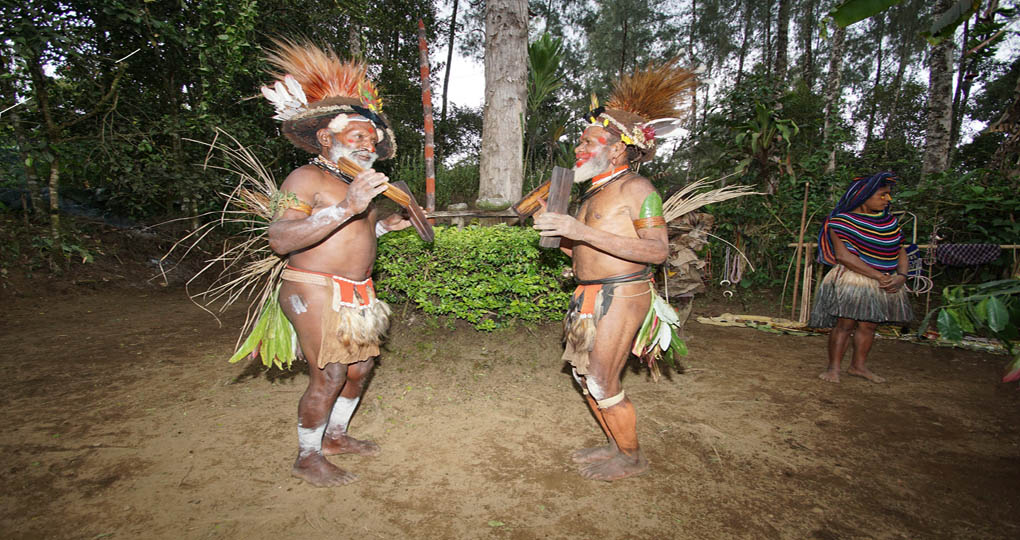
Here, many local tribes come together in a stunning visual display of costumes, body colouring, music, chanting, and dancing. For the whole day, a local sports field became a sea of motion, sound, and colour. What made this event even more fascinating was that it wasn’t just a display for tourists. In fact, we were the visible minority, as we dodged betel nut spittle, mud-spattered kids, and more than few friendly, if curious stares. Our day ended with a 45-minute climb up a rock-strewn mountain to the Wahgi Guest Haus, a rustic lodge with basic facilities. Yet it offered a welcome respite from the day, allowing time to reflect on this incredible sensory experience. The following day we were back to Rondon Ridge for a relaxing afternoon getting ready for our next adventure, exploring the mystical Sepik River region.
The next morning, we were off early to the Mt Hagen airport to meet our Aussie pilot for the 45-minute charter flight on a 6-seater propelled plane that took us down from the Highlands to the Sepik River Basin at Karawari, one of the Sepik’s main tributaries. From the cool, spring-like weather of the Highlands, we reached dense tropical lowland rainforest region, one of the world’s great, untouched rainforests. After a short walk through heat and humidity, we boarded a small shuttle boat for the quick ride upriver to the stunning Karawari Lodge, our home for the next two nights. Not only was the Lodge built to blend in with the landscape using local materials, its remote location and setting on a ridge overlooking the river and jungle-clad basin makes it one the most unique lodges in the world.
We set off on our first adventure across the river to a small village for a Sago Palm making demonstration. Sago is the staple food of the river people and the process of getting it from a tree trunk to an edible flour is very labour-intensive. It includes chopping the wood pulp, soaking and squeezing out the starchy residue, draining off the water, and forming dough balls, before flattening and frying the final product over an open fire. The end result was a bland, tortilla-like pancake that was then filled with fish or just eaten plain. Our evening was one of relaxation with a sundowner on the lodge veranda, a delicious dinner (sago optional) and a comfortable sleep in our mosquito-netted beds.
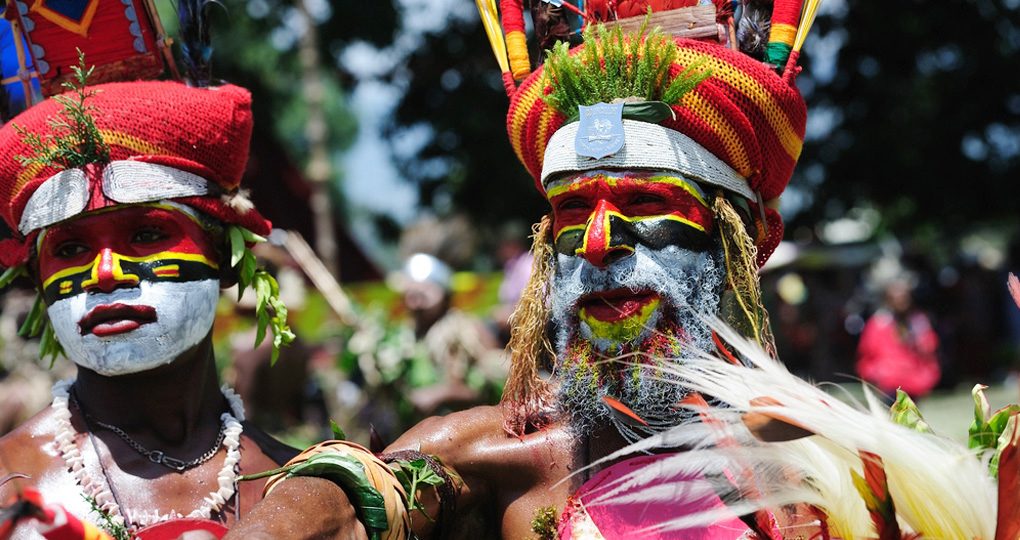

The next day was spent travelling up and down the tributaries in the area. Life in the Sepik Region revolves around the rivers and lakes of the basin; the waterways and the land on its fringes are the local lifeline, and day to day subsistence activities are molded to their ebb and flow. As we motored our way along, the power of the river was evident in every twist and turn we took. Narrow dug-out canoes glided by, full of goods to trade. Women fished or made sago. Kids shrieked and splashed in the water. Thatched-roofed villages suddenly came in to sight and people smiled and waved wherever we looked.
In the end, we visited three different villages, each with its own unique activity to show us. In one, we watched a re-enactment of a traditional dance ceremony and observed basket weaving and bilum (handbag) making. In another, we climbed a hill to see the remnants of a Spirit House ruined in a WW2 Japanese bombing raid. In the last, we visited the ‘man’s house’ to view historic carvings and to learn more about the art and belief systems of the region. Being immersed for a whole day in a seemingly idyllic lifestyle that has not much changed for thousands of years was deeply moving.
Our final adventure began the next morning as our 40-minute charter flight took us out of the lowlands and back up to the central mountains, this time to Tari in the remote Southern Highlands province. Amazingly, we were now in one of PNG’s most remote, undeveloped regions where the traditional warrior cultures of the Huli and Duna Wigman have thrived for thousands of years. Being able to observe and interact within a world that was only “discovered” in 1935 was a surreal and humbling experience. From the airport, we transferred up into the mist-shrouded mountains to Ambua Lodge arriving at the onset of a torrential downpour. We settled in to our well-appointed huts and spent the rest of the afternoon relaxing in the lodge’s lounge area in the company or our fellow travelers, walking through the lush gardens and admiring the magnificent views of the Tari Valley.
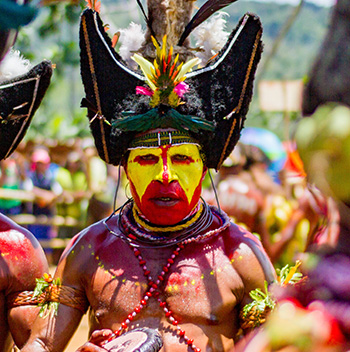

The next morning we were up before the sun to search out the elusive but beautiful Bird of Paradise, known for its long tail feathers and revered by the Huli. Our early rise was worth the effort as we traipsed through a marshy field to view these spectacular birds. Then it was back to the Lodge for a hearty breakfast, before a full day of cultural immersion into a world where clan dominance, war-like mentalities, ancestral spirits, sorcery, and pig wealth govern daily life. Our day included a warrior dance demonstration by yellow-faced Huli tribesmen, a visit to a Duna Wigmen ceremony to learn more about these elaborate and flamboyant headdresses, and a visit and walkabout in a local village. After another full day of overwhelming sensory experiences, Ambua was a welcome retreat before embarking on our long journey home the next morning.
For anyone with an adventurous spirit, PNG will not disappoint. Diving, fishing, surfing, trekking, bird watching, cultural activities, and exploring WW2 relics are all attractions on offer. But be prepared. Any visitor to PNG must come with an open mind, a sense of adventure, and a willingness to have all five senses come alive with new sensations. It is a country of extremes, from rain, to mud, to heat and humidity. There are trips along rain-gutted roads and places with no roads at all. But treasures also abound, from thousand year old wood carvings to WW2 relics. The locals are friendly, but wary in a land where stone-age traditions still prevail. Finding ‘the real PNG’ isn’t a problem here! It is a destination where, on arrival, you instantly know you are ‘not in Kansas anymore.’
But then, that is the best reason to make PNG your next great Globetrotting adventure.
For unique and innovative customized itineraries to Papua New Guinea please contact the tour planning experts at GroupsOnly by Goway
or contact us:
Tel: 800 838 0618
Web: www.goway.travel/groups
Email: [email protected]
